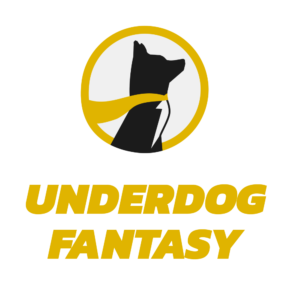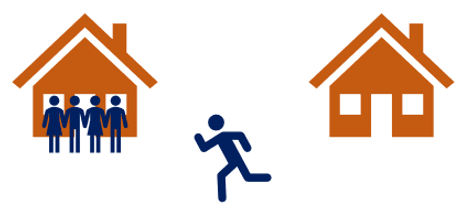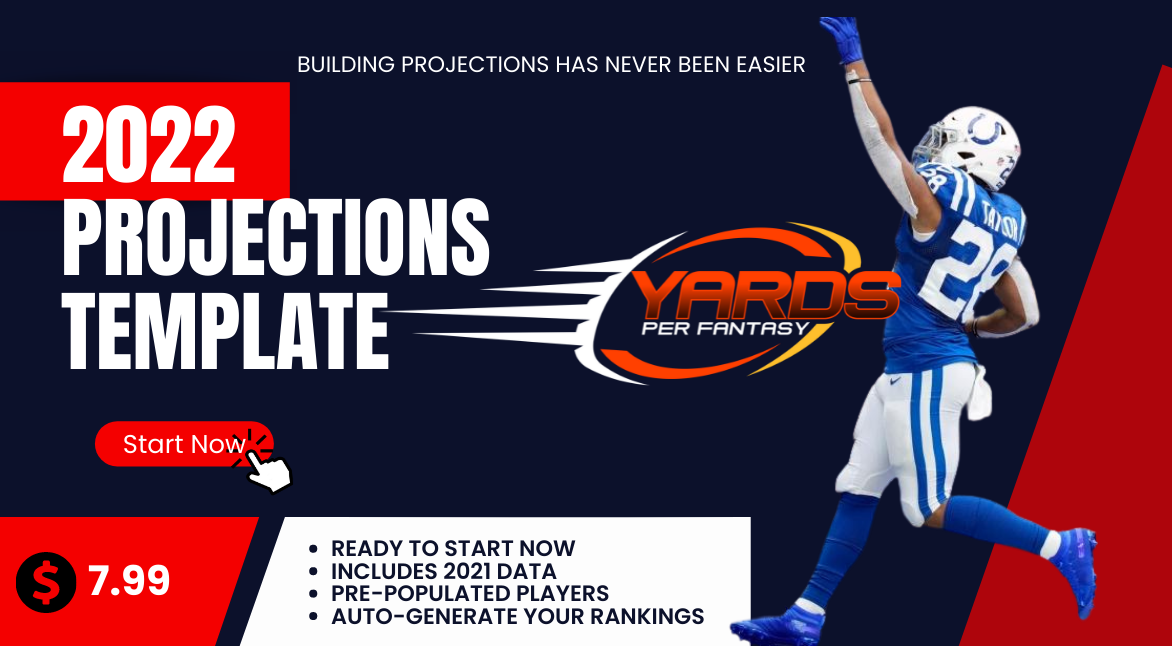 Draft With Us On Underdog! Use Promo-Code: YARDSPER for a 100% deposit match up to $100!
Draft With Us On Underdog! Use Promo-Code: YARDSPER for a 100% deposit match up to $100!
Ever been interested in trying a fantasy football auction draft but don’t know where to start to begin to prepare? Or have you been doing auction drafts for a few years, but want to take your preparation to the next level with a more principled, methodical approach? Whether you’re an experienced auction player or new to the format, the I’m here to help you improve your preparation for auction/salary cap drafts!
The Fantasy Football Auction Roadmap will soon be releasing for purchase on Yards Per Fantasy. The Roadmap will provide readers with an in-depth look at the best ways to prepare yourself for an auction draft to optimize performance around the factors you can control. Included in the Fantasy Football Auction Roadmap:
- Auction draft basics
- Psychological and behavioral-economic influences in an auction and how to use them to your advantage
- How to determine player values (conceptually and quantitatively)
- How to adjust player values based on the actual auction results
- Player nomination strategies both early and late in an auction
- Budgeting and roster construction strategies
- Personal favorite philosophies and strategies
- Applying fantasy football auction draft concepts in snake drafts and vice versa
- Draft day Excel document which provides:
- Player values (both superflex and non-superflex leagues)
- Adjustments to those values for “live prices” based on actual auction results
- Example budget
- Personal nomination targets
This article is part of a series of articles that will provide a free sneak peek at some of the types of concepts you can expect to learn about in the Roadmap. I previously wrote an article on auction draft basics and some of the allures of a fantasy football auction draft over a snake draft.
In this article, we’ll explore one of nine psychological and behavioral-economic factors present in auctions that will be explored in the Roadmap, and how it influences fantasy football auction draft results: Social Proof.
Social Proof
Social proof is a psychological phenomenon where the actions of other people inform one’s own decisions. In some cases, a person may simply emulate the actions of others in an attempt to reflect the correct behavior for a given situation. When we see groups of others taking a certain position (i.e., a consensus), we are more likely to replicate that action.
This phenomenon is present in many aspects of our lives. In the United States, for example, a majority of the population is “Team iPhone” for their smart phone of choice, but this is largely driven by the fact that most people have iPhones rather than a deeper understanding of the specs of the iPhone versus its competition. Similarly, if you’re looking for a place to grab a Friday night drink with a friend on a street full of restaurants and bars, you’re likely not going to pick the one that is empty. Instead, you’ll more likely choose a busier establishment because you assume that something must be wrong with the empty bar if nobody is there.

The same concept is at work in an auction. If nobody is bidding, we sometimes subconsciously question our own judgements. However, as soon as (and the more that) others bid higher on a player, it validates that other people see value at the current price, triggering other potential buyers to join in. In one research study performed in 2014, the researchers found that low competition in an auction reduced preference for an item, while high competition increased preference. The findings supported a view that competitors’ bids in auctions are perceived as a valid social signal for the common or intrinsic value of an item. That is, the researchers believe that the influence of social information constitutes a major cause for the frequently observed deviations from optimal auctions outcomes or values.
This concept is inherently related to many studies that have found that lower starting prices in an auction result in higher final prices. There are three primary reasons for this:
- Social proof. That is, lower starting prices reduce barriers to entry to an auction, which leads to even idle browsers place bids. The increased ‘traffic’ may cause later bidders for the item to take the large number of early bidders as proof of an item’s worth.
- Similar to social proof, the more traffic is created, the more momentum there is, and the higher a final price often becomes.
- Sunk Cost Fallacy. The sunk cost fallacy is a behavioral-economic concept, which states a person will be willing to do something to their own detriment if they had previously invested significant time or money in an opportunity. Thus, in an auction, when there are lower starting prices and a participant has already bid a number of times, that participant will be more willing to continue to bid because they have invested time and energy into the auctioned item already.
There are two ways to take advantage of social proof in an auction draft:
- Evaluate early market prices and adjust your strategy based on your prepared prices, and
- Influence bidding momentum.
Evaluate Early Market Prices and Adjust Your Strategy
Avoiding the influences of social proof requires an unbiased approach to bidding and a strong conviction in the prices you set for the players during preparation. Having conviction in your preparation and prices is crucial. Without that conviction, you will inevitably fall victim to social proof, allowing others to influence the price you’ll pay for players while ignoring your own pre-determined prices.
Sticking to your price sheet is essential to find values and deals in an auction. For example, once a price level is established for a certain tier within a position, other players in that tier will likely go for the same/a similar price. For example, if Davante Adams goes for $40, Stefon Diggs is also likely to go for around $40. It often doesn’t matter what prices those receivers should go for based on price sheets; the market has been set, and managers will pay a similar price for a similar caliber of player.
Suppose you believe Adams and Diggs should be worth closer to $35. If you identify that these prices are higher than what you have on your price sheet, then you will immediately know that value is being created either at lower tiers and/or other positions. This is because the prices set early will feed into others’ sense of consensus prices for similar tiers of players, and they will adjust their prices based on the newly obtained social proof. However, if you fall victim to bidding along with the price levels set by others while ignoring your sheet, you will do yourself and your preparation a disservice, as you will sacrifice the value that is being created in other areas of the draft. This concept will be explored more completely in the Fantasy Football Auction Roadmap.
So long as you stay confident in your own pricing and preparation, it allows you to evaluate the positional markets early in an auction, and understand where the value is going to be for you. While it can be difficult to restrain yourself bidding past your prices for certain players, doing so will allow you to zig into value while others zag, and give you the best chance to leave the draft with the most value possible.
PROJECTIONS TEMPLATE – GET NOW!
Influence Bidding Momentum
You can also take advantage of social proof via controlling bidding momentum in the auction of a specific player. Research has established that low competition and bidding traffic in an auction generally leads to lower final prices for the item. It stands to reason, then, that for players that you like more and hope to get on your team, you should aim to reduce bidding traffic, and for players you do not want, you should look to increase bidding traffic. But how do you do this? There are a few ways, all of which are most applicable early in the auction.
One strategy (which is covered in more detail in the Fantasy Auction Roadmap) is to nominate players that you do not want on your roster early. This is a viable strategy in part because increases the amount of bidding traffic for a player. The more people who bid on the player, the more social proof of the player’s value, and the more others will continue to bid. This, in turn, will drive up the price of that player.
When nominating that unwanted player, you should also set the opening bid at $1. As discussed above, the lower starting price reduces barriers to entry, allows even idle auction-goers to place a bid, and thus increases traffic and momentum. For players that you are confident will go for relatively high prices (e.g., $30 or more), you can get in on the bidding early as well, increasing the bid by no more than $1 each time, to increase the number of total bids being made and adding yourself to the mix as another bidder. This will serve to increase the impact of social proof for others and give them confidence to continue to bid higher on the player you do not want. Of course, you should be careful to not somehow get caught with a bid so high that you are in danger of accidentally winning the bid for the player at a price you would regret, so it’s best to only add yourself to the mix early when that risk is extremely low and/or you would be ok winning the player at such a low price.
On the flip side, when a player you are high on is up for auction, you should be bidding in a way that will reduce traffic and momentum, and thus generally lead to a lower end price. The best way to reduce traffic is to place a relatively high, aggressive bid early in the auction in order to 1) price out some of your competitors early, 2) reduce the number of total bids, and 3) force others to pause and rethink where the bid is at so as to slow the timing of the next bid. For example, if I personally really like a player and his potential, when he is nominated, I might immediately bid $28 if he is priced at $40 on my sheet. If I get that player for $28, that would be a $12 bargain in my eyes, so I would be happy to win at that price. But even if I don’t win at that price, I will have reduced the number of people who ultimately put bids in, and reduced the number of total bids made, reducing the impact of social proof on the auction (and improving the likelihood of getting a bargain on the player).
If you like the approach of this article, keep an eye out for the Fantasy Football Auction Roadmap coming out soon, which will examine many more psychological and behavioral economic concepts and how they influence the results of auction drafts, among many other ways to better prepare for your auction drafts!






